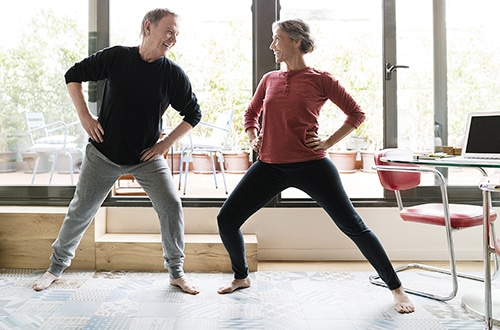Short exercises add up.

Three minutes per hour of activity can pay dividends.
Sit less, move more. You know you should. But all too often, time gets away from you and before you know it you’ve been on your backside for four hours straight.
What’s more, research has found that Australians, many of whom have been stuck at home, are spending more time seated during the pandemic.
For sports physiotherapist Paul Dardagan, that’s worrying, because a highly sedentary lifestyle is associated with numerous health risks, including early death, diabetes, heart disease and poor mental health.
Dardagan, who is co-owner of Sydney clinic bounceREHAB, suggests people should be getting up every hour – and he says that’s a conservative recommendation.
‘‘I know it seems like overkill. But getting up and going to the toilet, getting a drink, talking to a co-worker, all counts, just get up and stand as often as you can.’’
Or, be more deliberate about it. Dardagan says three minutes of light exercise every hour can make a big difference. If you struggle to remember, set reminders on your phone (apps such as Stand Up! can help you do this).
Dardagan has designed a short routine involving five simple movements that he says incorporate strength, stretching and light cardio. He says they can be done from anywhere, but are particularly valuable for people working at home.
‘‘The formula is to get people up and moving, get their compound muscle groups warmed up so that it stimulates our heart,’’ he says.
The movements should be appropriate for most people, Dardagan says, but if anyone has any difficulty, they should consult a physiotherapist.
Calf Raises
Dardagan recommends starting with calf raises to help fire up your engine.
‘‘When we sit for a long period of time, our calves get quite lazy,’’ he says, adding that this is particularly important for people with knee, hip or back issues as they often suffer from poor calf strength and endurance. How to do it: Stand tall and lift your heels up and down off the floor. Try to hold your position at the top for an extra second or two and slow your movement as you return to the ground. Place a hand on a wall or chair if you need to for balance. Do this 20 times.
Chin Tucks
Dardagan says this one will help wake up the stabilising muscles at the back of your neck and is particularly great for anyone who works on a computer all day or suffers from ‘‘tech neck’’.
‘‘When you hang off your head all day looking down at your computer, with that forward chin posture, you’ll develop trigger points in your neck and back of your skull that causes tightness.’’ How to do it: Stand tall and place an index finger on your chin. Activate the muscles in the back of your neck to slowly draw your chin backwards. Imagine you’re giving yourself a double chin. Do this 10 times.
Shoulder Rolls
Dardagan says shoulder rolls can help relieve stiffness or tightness and reduce the likelihood of headaches. ‘‘This is really good if you’ve been hunching and using your mouse all day,’’ he says. How to do it: Roll your shoulders backwards. One full circle is one repetition. Do this 10 times.
Shoulder Stretch
This one is about stretching, not strengthening, the shoulder muscles to help
loosen them up. People who get tight in this area can develop neck pain and
tension headaches, says Dardagan. How to do it: Pull your right shoulder
across your body by placing your left hand on your right elbow. Hold it there
for 45 seconds. Repeat on the other side.
Squats
Dardagan says this short burst is about stimulating your heart and getting blood pumping around your body. How to do it: Stand tall with your feet about shoulder-width apart and put your hands slightly in front of you with fingers clasped. Next, imagine you’re sitting back into a chair and lower yourself until your thighs are as close to parallel with the floor as possible, with your knees over the top of your ankles. Look straight ahead with your chest opened up and allow your lower back to arch slowly as you go down rather than hunch. Keep your weight in your heels, not your toes, and push through your heels to stand back up. Do this 10 times.
Source: The Age Online, article written by Sophie Aubrey.